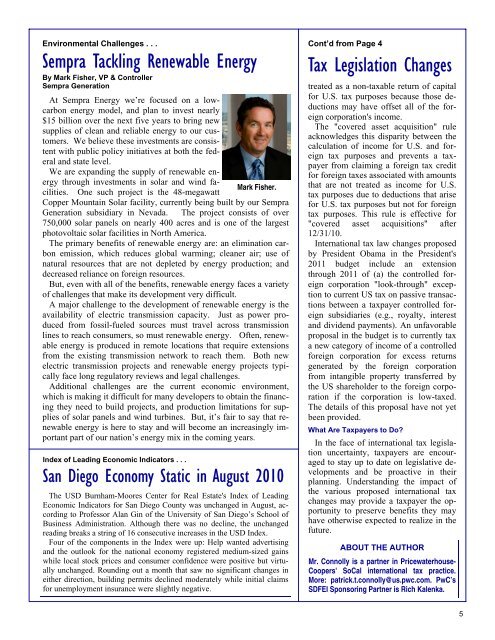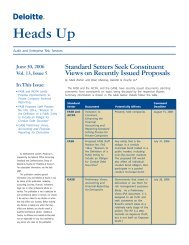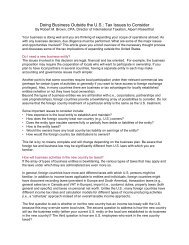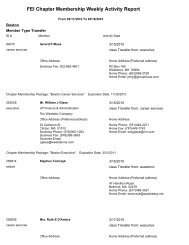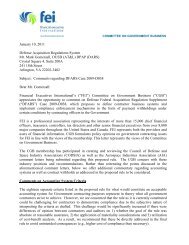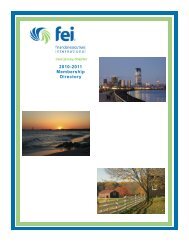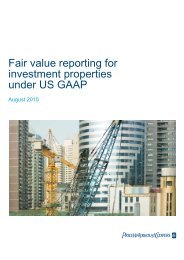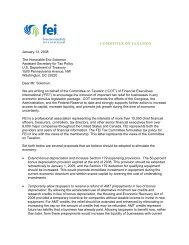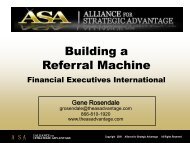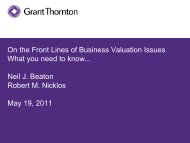October 2010 Newsletter - Financial Executives International
October 2010 Newsletter - Financial Executives International
October 2010 Newsletter - Financial Executives International
You also want an ePaper? Increase the reach of your titles
YUMPU automatically turns print PDFs into web optimized ePapers that Google loves.
Environmental Challenges . . .<br />
Sempra Tackling Renewable Energy<br />
By Mark Fisher, VP & Controller<br />
Sempra Generation<br />
At Sempra Energy we’re focused on a lowcarbon<br />
energy model, and plan to invest nearly<br />
$15 billion over the next five years to bring new<br />
supplies of clean and reliable energy to our customers.<br />
We believe these investments are consistent<br />
with public policy initiatives at both the federal<br />
and state level.<br />
We are expanding the supply of renewable energy<br />
through investments in solar and wind fa-<br />
Mark Fisher.<br />
cilities. One such project is the 48-megawatt<br />
Copper Mountain Solar facility, currently being built by our Sempra<br />
Generation subsidiary in Nevada. The project consists of over<br />
750,000 solar panels on nearly 400 acres and is one of the largest<br />
photovoltaic solar facilities in North America.<br />
The primary benefits of renewable energy are: an elimination carbon<br />
emission, which reduces global warming; cleaner air; use of<br />
natural resources that are not depleted by energy production; and<br />
decreased reliance on foreign resources.<br />
But, even with all of the benefits, renewable energy faces a variety<br />
of challenges that make its development very difficult.<br />
A major challenge to the development of renewable energy is the<br />
availability of electric transmission capacity. Just as power produced<br />
from fossil-fueled sources must travel across transmission<br />
lines to reach consumers, so must renewable energy. Often, renewable<br />
energy is produced in remote locations that require extensions<br />
from the existing transmission network to reach them. Both new<br />
electric transmission projects and renewable energy projects typically<br />
face long regulatory reviews and legal challenges.<br />
Additional challenges are the current economic environment,<br />
which is making it difficult for many developers to obtain the financing<br />
they need to build projects, and production limitations for supplies<br />
of solar panels and wind turbines. But, it’s fair to say that renewable<br />
energy is here to stay and will become an increasingly important<br />
part of our nation’s energy mix in the coming years.<br />
Index of Leading Economic Indicators . . .<br />
San Diego Economy Static in August <strong>2010</strong><br />
The USD Burnham-Moores Center for Real Estate's Index of Leading<br />
Economic Indicators for San Diego County was unchanged in August, according<br />
to Professor Alan Gin of the University of San Diego’s School of<br />
Business Administration. Although there was no decline, the unchanged<br />
reading breaks a string of 16 consecutive increases in the USD Index.<br />
Four of the components in the Index were up: Help wanted advertising<br />
and the outlook for the national economy registered medium-sized gains<br />
while local stock prices and consumer confidence were positive but virtually<br />
unchanged. Rounding out a month that saw no significant changes in<br />
either direction, building permits declined moderately while initial claims<br />
for unemployment insurance were slightly negative.<br />
Cont’d from Page 4<br />
Tax Legislation Changes<br />
treated as a non-taxable return of capital<br />
for U.S. tax purposes because those deductions<br />
may have offset all of the foreign<br />
corporation's income.<br />
The "covered asset acquisition" rule<br />
acknowledges this disparity between the<br />
calculation of income for U.S. and foreign<br />
tax purposes and prevents a taxpayer<br />
from claiming a foreign tax credit<br />
for foreign taxes associated with amounts<br />
that are not treated as income for U.S.<br />
tax purposes due to deductions that arise<br />
for U.S. tax purposes but not for foreign<br />
tax purposes. This rule is effective for<br />
"covered asset acquisitions" after<br />
12/31/10.<br />
<strong>International</strong> tax law changes proposed<br />
by President Obama in the President's<br />
2011 budget include an extension<br />
through 2011 of (a) the controlled foreign<br />
corporation "look-through" exception<br />
to current US tax on passive transactions<br />
between a taxpayer controlled foreign<br />
subsidiaries (e.g., royalty, interest<br />
and dividend payments). An unfavorable<br />
proposal in the budget is to currently tax<br />
a new category of income of a controlled<br />
foreign corporation for excess returns<br />
generated by the foreign corporation<br />
from intangible property transferred by<br />
the US shareholder to the foreign corporation<br />
if the corporation is low-taxed.<br />
The details of this proposal have not yet<br />
been provided.<br />
What Are Taxpayers to Do?<br />
In the face of international tax legislation<br />
uncertainty, taxpayers are encouraged<br />
to stay up to date on legislative developments<br />
and be proactive in their<br />
planning. Understanding the impact of<br />
the various proposed international tax<br />
changes may provide a taxpayer the opportunity<br />
to preserve benefits they may<br />
have otherwise expected to realize in the<br />
future.<br />
ABOUT THE AUTHOR<br />
Mr. Connolly is a partner in Pricewaterhouse-<br />
Coopers' SoCal international tax practice.<br />
More: patrick.t.connolly@us.pwc.com. PwC’s<br />
SDFEI Sponsoring Partner is Rich Kalenka.<br />
5


